How to Enjoy Cape Town, South Africa on a Budget
12 Must-Dos in the Country's Mother
City
Article and photos by Lies
Ouwerkerk
Senior
Contributing Editor
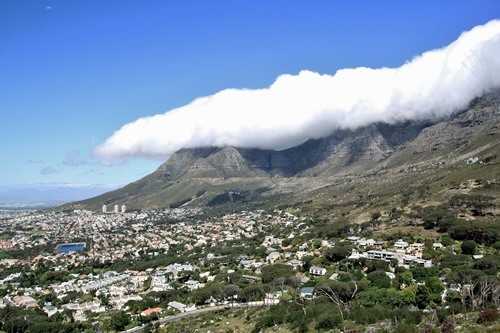
|
|
Cape Town with Table Mountain
complete with the famous "table cloth" clouds in the
background. Photo by cocoparisienne.
|
1) Live with Capetonians and
Share their Daily Lives
Get to know the country through its
people!
During a recent stay in Cape Town,
I rented rooms with annex bathrooms through AirBnB
and VRBO (editor's note: see our section on vacation
home rentals), averaging about $40 per night. It
was a great opportunity to meet extraordinary locals
who picked me up at the airport, drove me to places in
and around the city, invited me to their tables to wine
and dine, provided me with great tips and let me pose
them probing questions about anything South African.
Above all, they offered me a most valuable insight into
daily life in Cape Town.
2) Get Your Bearings Around
the City Bowl
As I was totally new to Cape Town
and in need of a quick heads-up of the inner city — the
so-called City Bowl — I signed up for two free half-day
walking tours. Cape Town Free Walking Tours organizes
one walk along the landmarks of the historic city to
give visitors an idea of the Cape’s architecture and
troubled yet fascinating history and politics, and another
around the colorful Bo-Kaap district, formerly known
as the Malay Quarter, and inhabited by many descendents
of former slaves from various African and Asian countries.
Visit the website of Free Cape
Town Walking Tours for
more information. No costs, but a tip is appreciated.
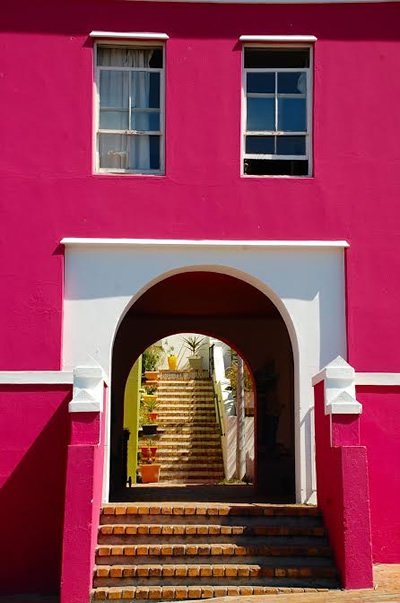
|
|
House in picturesque Bo-Kaap.
|
3) Explore Larger Cape Town
and its Surroundings
To get a better idea of the layout,
scenery, and other offerings in the city and the Cape
Peninsula at large, the hop-on hop-off bus is ideal for
covering it all in one day. Via the District Six Museum
(do visit this testimonial of forced removal of blacks
under Apartheid!), the impressive — world’s first — botanical
garden Kirstenbosch and the 17th century Constantia wine
estate, the Blue Line continues through the seaside towns
of Hout Bay, Camps Bay, Clifton, and Sea Point, offering
spectacular views, beautiful beaches, and trendy side
walk cafes.
Visit the City
Sightseeing South Africa website for more information.
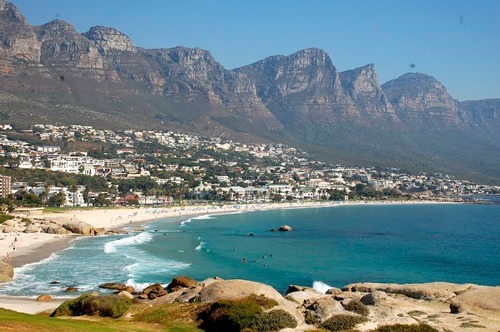
|
|
With hop-on hop-off bus
along the coastal towns of Clifton and Camps Bay
near Cape Town.
|
4) Pay a Visit to Robben Island
Although Robben Island is one of
Cape Town’s biggest tourist attractions, and you are
definitely not the only visitor to the island, walking
through the site where many South African freedom fighters
were incarcerated — including Nelson Mandela — was
one of the highlights of my stay in Cape Town. Not only
do previous political prisoners function as guides and
make the stories about past life in the maximum-security
facility more interesting, but you also have a chance,
as I had, to bump into former prison guards such as Christo
Brand. Brand is the author of the book My Prisoner,
My Friend, and was more than happy to exchange some
salient anecdotes about his involvement with Mandela
during his 27-year imprisonment.
Advance booking is highly recommended,
and can be done online at the Robben
Island website.
Costs: $25, including boat and guided bus tour over the
island.
Because of rough seas, tours are
regularly cancelled, which will be communicated to ticket
holders by email on the day of the tour. It is therefore
advised not to plan a visit to Robben Island for one
of your last days in Cape Town, but rather leave some
room for potential rescheduling.
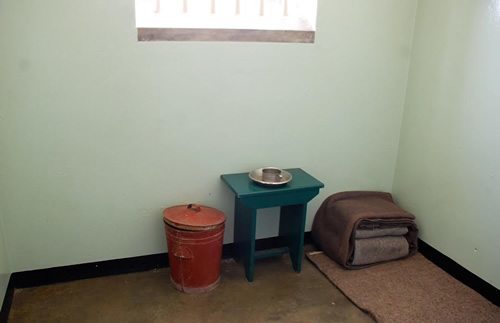
|
|
Mandela's prison cell on Robben
Island.
|
5) Stroll Over Neighborhood
Markets and Eat Your Heart Out
Cape Town is experiencing a true
Renaissance in neighborhood markets, held in parks, squares,
and heritage buildings, where Capetonians trade artisan
food, farm-fresh produce, curios, unique handicrafts,
jewelry, antiques, designer goods, second-hand vintage
clothes, books, wines, and craft beers.
Enjoy an affordable lunch at one
of the stalls at the lively markets of the Old Biscuit
Mill and the Palms, both in the Woodstock area, where
you’ll also encounter the highest concentration of contemporary
designer and artists’ studios, coops, and galleries in
town.
Or combine a visit to False Bay (see
#10) with a stroll and dinner at the Friday Blue Bird
Garage Food and Goods Market in Muizenberg, located in
an old postal plane hangar.
The Pan African Market, housed in
a historic building on downtown’s Long Street, is all
about jewelry and folk art, with representatives from
many West, sub-Saharan and southern African countries.
There is a quaint terrace on the first floor.
For more markets and their locations
in and around Cape Town, visit the Cape
Markets and Mother
City Living: Slow Food & Green Living in Cape Town websites.
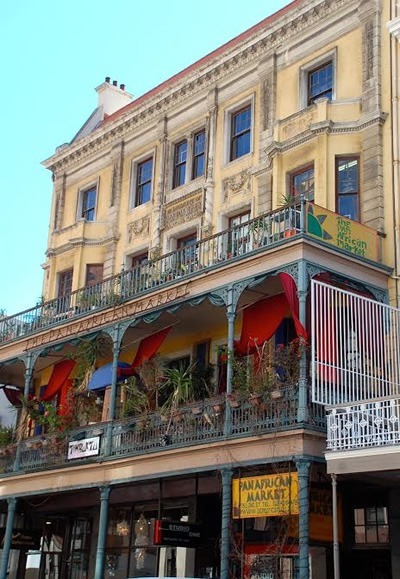
|
|
The Pan African Market in
Cape Town.
|
6) Engage in an Outdoor Activity
Could you see yourself tandem paragliding
from Lion’s Head with one of the many paragliding companies
in Cape Town and taking in the stunning views of flat-topped
Table Mountain, one of world’s 7 natural wonders, towering
above the Cape Peninsula? Or, if that is too extreme,
how about hiking the scenic trails of Table Mountain
National Park? You can do it solo, or with a guide from
a company like Hike
Table Mountain. Although the latter organizes guided
hikes for all levels of fitness, the climb to the top
is not for the fainthearted! For those who have second
thoughts, the trip up Table
Mountain can also be done by cable car. If you specifically
go for the view, keep an eye out for low-lying cloud
forming (the "table cloth"), especially with
S.E. winds.
Cape Town and surroundings have opportunities
galore for other outdoor activities as well, including
surfing, fishing, kayaking, rock climbing, cycling (also electric
bikes), mountain biking, sand boarding, game drives
and bush camping. For more info on all kinds of outdoor
pursuits, visit the SAN
- South African National Parks and Uncover
the Cape websites.
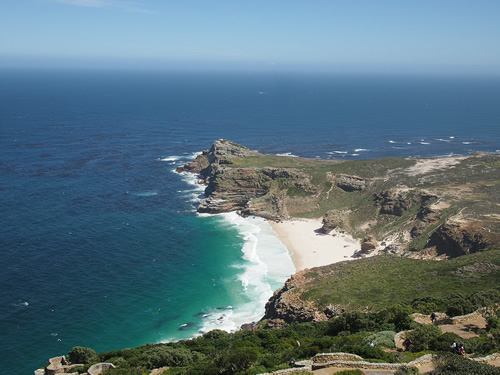
|
|
Enjoy views from above after
hiking in hills near and above Cape Town. Photo
by MichiBieri.
|
7) Taste Wines at a Historic
Estate
Wine tasting is a must when surrounded
by so many vineyards and wine cellars on the Cape Peninsula,
including those of famous Stellenbosch, Franschhoek,
and Paarl. Many of the hundreds of vineyard estates in
the foothills of Table Mountain are handed down from
generation to generation and still possess their old-world
charm, featuring a Cape Dutch architectural style. Nearly
all of them offer wine tasting tours, which can be joined
privately or through a group tour, departing from Cape
Town or Stellenbosch. Typically, you can taste about
five different wines, starting with the dry whites, then
the reds, and topping it off with a sweeter dessert wine.
For information on guided tours visit
the WineToursCapeTown.com, Cape
Town Day Tours, Bikes
‘n Wines, and Wine
Flies Wine Tours websites.
Costs: $40-$60.
If going solo and taking the train
to Stellenbosch: the train runs every 1½ hours from CT
Railway Station, and takes about 1 hour and.20 minutes.
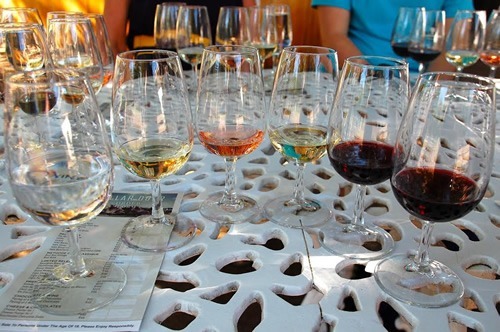
|
|
Wine tasting in Stellenbosch.
|
8) Learn About the Cape’s Traditional
Foods
Many different nationalities have
called the Mother City home over the last couple of centuries,
including the Dutch, French, English, Germans, Malay
slaves, and indigenous tribes, so the Cape cuisine is
considered a true melting pot of culinary influences.
For a newcomer to Cape Town, the
names of some typical foods are truly challenging. What
to make of waterblommetjie bredie, bobotie, potjeskos,
koeksisters, sosaties, smoorsnoek, boerewors, and slaphakskeentjies, for
instance?
In order to master some traditional
South African recipes, I joined both a Malay cooking
class in the Bo-Kaap district, and a food tour along
various culinary highlights in town.
In the cooking class we made finger
licking samosas and a Cape Malay curry, and we ate delicious
koeksisters (sticky sweets resembling our donuts) for
dessert.
During the food tour, we visited
the Company Gardens, the very spot where Jan van Riebeeck
discovered the abundance of fresh water, fertile soil,
rich marine life, and started South Africa’s first garden
in 1685. I also had a traditional Xhosa lunch at the
home of a well-known trumpeter with whom I shared isopho (corn
bean soup) and umpoqhoko (maize porridge). In
Gugulethu Township, my guide introduced me to a typical braai (BBQ)
at the iconic Mzoli’s, where guests pick their own cut
from the butchery counter, and then eat it off a tin
plate in the adjacent canteen.

|
|
"Braai" (BBQ) is prepared
at Mzoli's.
|
Food Tour: Coffeebeans
Routes.
Cost: $100 (NB: although it was an enjoyable experience,
this tour seemed grossly overpriced, and did not enough
highlight the multicultural aspect of Cape Town’s cuisine).
Interactive meals with local hosts
on their own turf are offered by Dine-with-a-Local.
Costs are around $30, depending on number of people.
9) Participate in a Tour Through
the Townships
Under Apartheid, many black and colored
families were forced into settlements on the periphery
of the metropolis, the so-called Townships. For a balanced
view of life in Cape Town, these settlements are as central
to any visit to the Peninsula as for instance the Winelands
and Table Mountain.
The focus of our tour, which employed
locals as tour conductors for a first-hand experience,
was on the people who live in the Townships, their struggles,
triumphs, resilience, and solidarity. A lunch at a local’s
house was included. The outing can also be combined with
a gospel tour, a social soccer game with local teens
and kids, or a homestay.
Visit Camissa, AWOL
Tours, Proteam
SA Tours websites for more information.
Costs are $45 - $75.

|
|
Xhosa hosts in Gugulethu Township.
|
10) Hop on the Train to False
Bay
The Atlantic Ocean with its beautiful
sandy beaches is always beckoning! For a few bucks you
can enjoy a scenic train ride to the seaside villages
of Muizenberg, Kalk Bay, and Simons Town. Muizenberg
has the perfect beach for surf lessons, Kalk Bay is known
for its bohemian, arty vibe, and fresh seafood (recommended
harbor restaurants: Harbour House, Live Bait, and Lucky
Fish), and Simons Town is just around the corner from
the endangered African Penguin colony at Boulders Beach,
which can be viewed at close range from boardwalks or
a kayak.
Visit SANParks
- South African National Parks for more information.
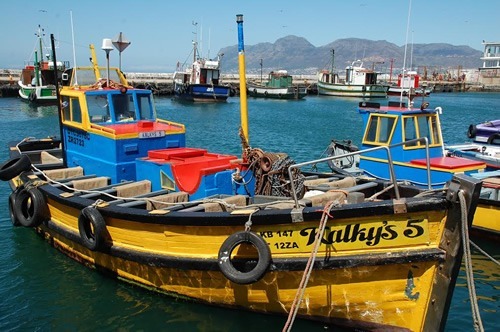
|
|
Kalk Bay Harbor.
|
11) Enjoy the South African
Beat
Music is big in Cape Town. There
are many annual music festivals such as the International
Summer Music Festival in January, the International Jazz
Festival in March, the Big Band Festival in May, the
Marimba Festival in June, and the International Opera
Festival in September.
Over the summer (November – February),
there are also regular picnic concert series held in
the Botanical Garden or on the lawns of various wine
estates.
For the most up-to-date music calendar
visit CapeTownMagazine.com.
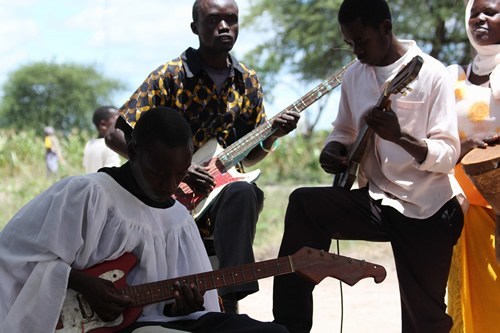
|
|
Photo by Hugh Grant.
|
12) Let it All Soak in a Turkish
Bath
With such an action-packed program,
nothing feels better than a good hot soak to relax.
Although by no means a fashionable,
state of the art facility, there is something very charming
about the 1908 Turkish Baths at the very end of Long
Street (mountainside). Massages are unfortunately a perk
of the past, but the use of steaming room, sauna, day
bed, and towel are still a good deal for the entry fee
of $3 per hour and $6 for 4 hours. There are different
days and times for men and women. There is also a public
swimming pool in the building ($1).
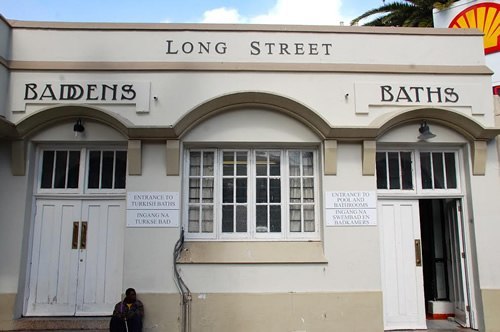
|
|
Turkish Baths.
|
Lies
Ouwerkerk is originally from Amsterdam,
The Netherlands, and currently lives in Montreal,
Canada. Previously a columnist for The Sherbrooke
Record, she is presently a freelance writer and
photographer for various travel magazines.
|
